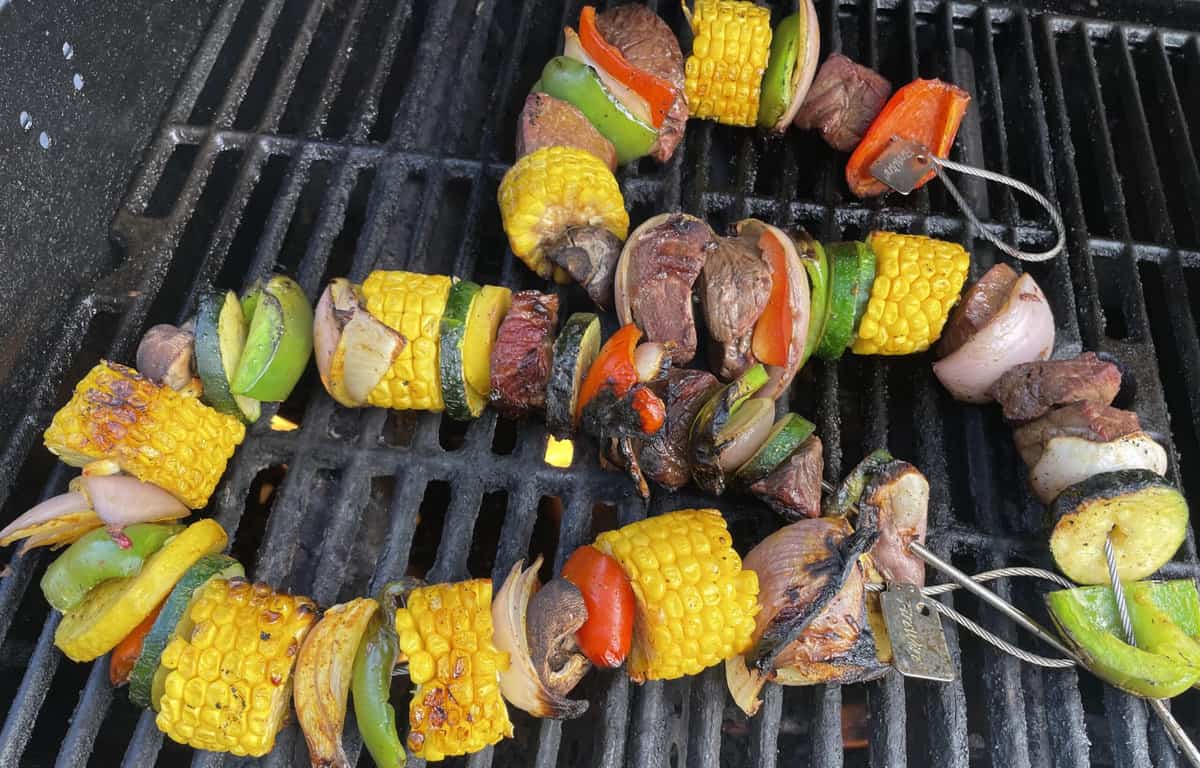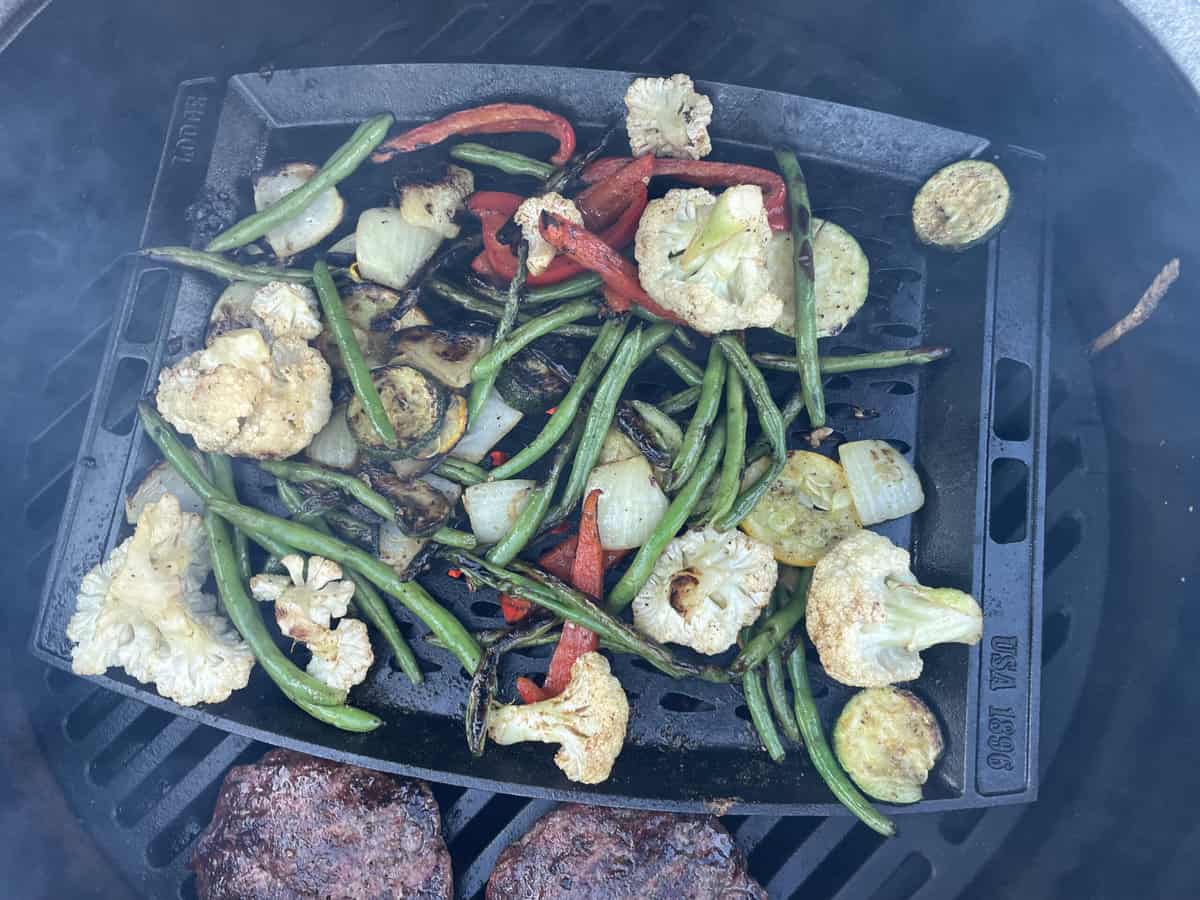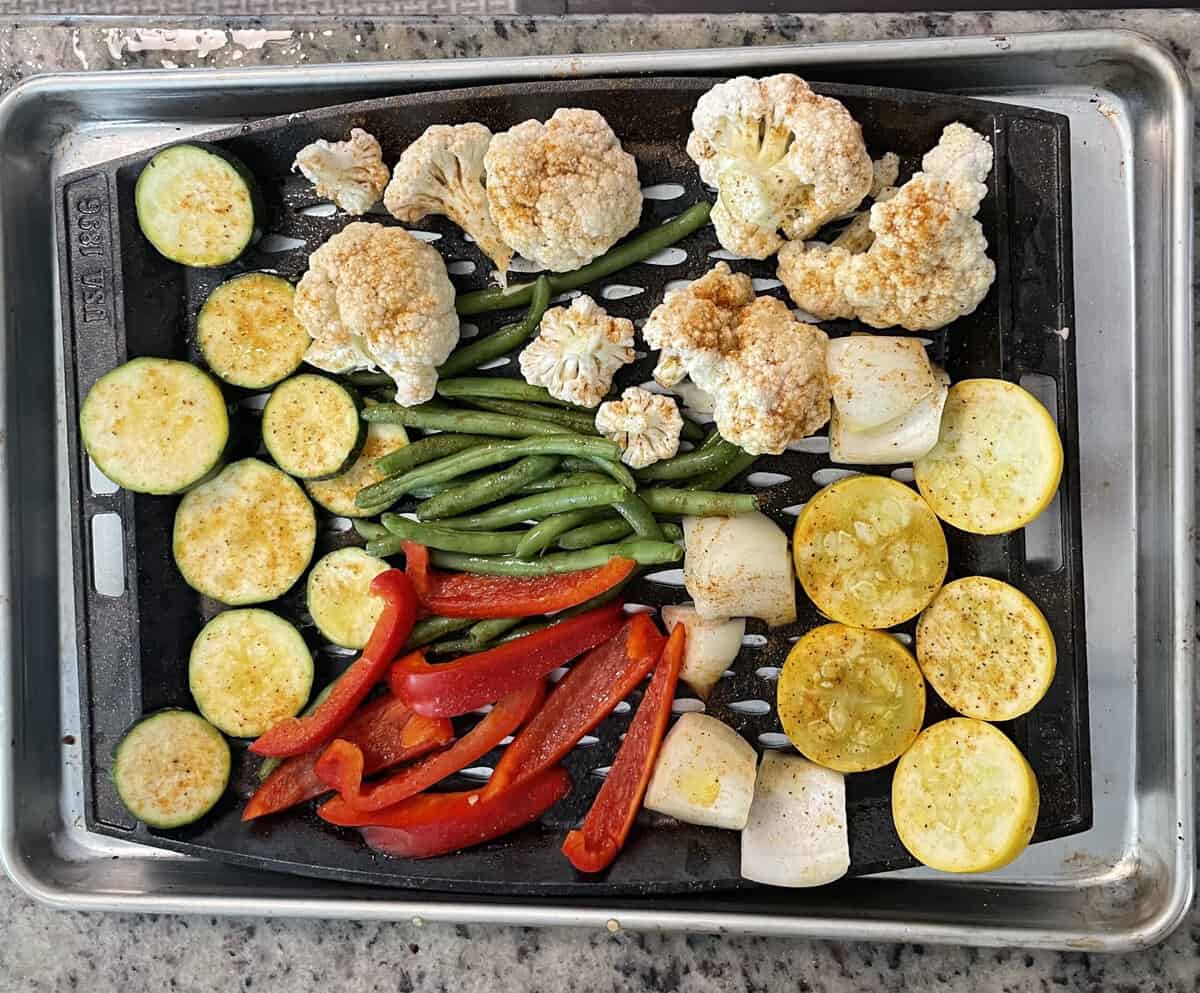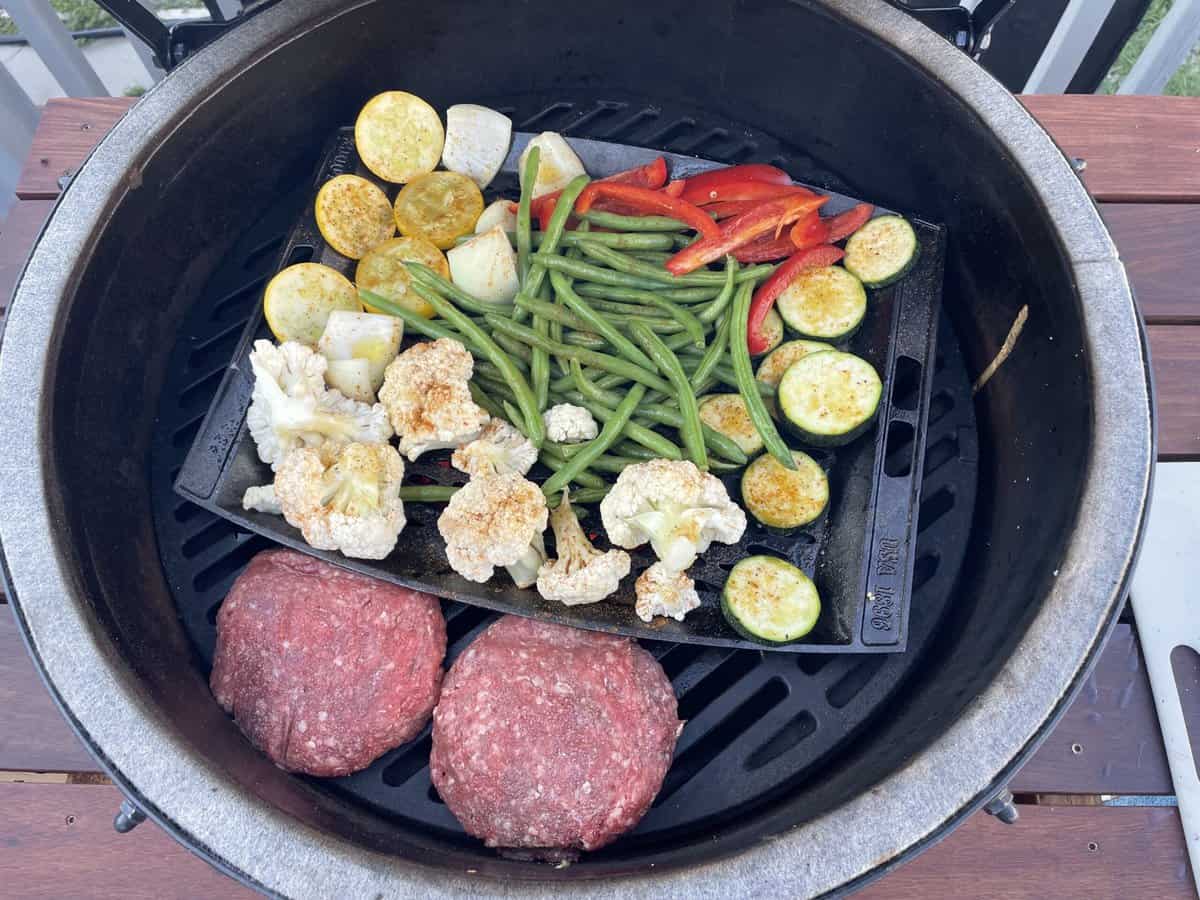You know what they say about summer barbecue season: It never has to end. That’s right, you can keep grilling in cold weather and continue smoking the world’s best dishes right through late autumn and even the turn of the calendar year.
Almost any time is right for an outdoor grill, as long as you plan ahead, choose the right meats and vegetables, take safety precautions, and listen to our advice.
It doesn’t matter whether you are using a Traeger wood pellet grill, a Weber gas grill, Pit Boss smoker, a Big Green Egg ceramic cooker, or your trusty kettle charcoal grill. Colder weather doesn’t have to get in your way.
A spatula is as good as a sled during a peaceful snow. Break out the mini grill lights, hot cider, and an old grill jacket, because we’ve got 20 hot tips for cold grilling.

1. Shop Smart for Seasonal Food
As a general rule, be sure to barbecue foods that can be grilled or smoked more quickly. You can keep the ribeyes coming like summer, but shop for smaller and thinner cuts of meat that take less attention in the frosty climes.
It’s a good time to grill fish on wooden planks for short cooking times. Try to avoid more flipping and basting than you have to.
Get a grill topper and have fun with butternut squash, beets, broccoli, and spiced onions. Root veggies and cruciferous veggies are at their peak of ripeness, so go with the flow.
The bottom line is you don’t need to be out in the cold any longer than necessary, especially bitter cold!
2. Prep Everything in Advance
In addition to those food choices, be sure to prep foods ahead of time as much as possible and have everything where you need it. All your seasonings, rubs, glazes, and side dishes should be organized in advance. Don’t spend extra time standing in the cold doing the little stuff.
3. Keep it Covered Throughout Extreme Weather
You should keep your grill covered year-round anyway, but especially in the colder months and if your weather includes snow and ice. It’s always easier to pull off an iced-over grill cover than it is to brush or scrape off ice, and piled-on snow can cause rust for metal grills or make Kamado cooker domes stick.
Go for a quality thick cover, like Covers & All. I bought a Big Green Egg brand cover at Ace Hardware to cover both a large EGG and table nest and found it to be flimsy and whipped off by strong winds in any season even with Velcro attached. Don’t cut corners.
4. Winterize the Grill Before Using It
Give your gas grill a thorough inspection before barbecuing in the cold and make sure it’s clean and oiled. Look over any hoses, burners, jets, and gas lines in case of blockage and clogs that can restrict gas flow.
Any flames should burn blue, not yellow, which could indicate blocked air inlets or burners to adjust. Apply canola or vegetable oil to help keep grates lubricated. Use a hair dryer if you need to defrost a stuck lid or frozen knob, and never force them.
If you try to lift an uncovered Big Green Egg or Kamado Joe Big Joe that’s been frozen, it can rip off the gasket, and that means going through the steps to install a new one while it’s frigid.
5. Take Advantage of the Light
It’s even colder when the sun goes down, and it goes down quickly at this time of year. It’s a lot different than that day you grilled for a family reunion on the Fourth of July. Plan to get your BBQ game going earlier in the day and maybe eat earlier. Know the time of sunset and back out your cooking time accordingly. Either way, you should add some outdoor lighting to your grill zone, like a Cuisinart LED flexible mini grill lights with a magnetic base.

6. Invest in a 365-Day Smoker
Buy a Big Green Egg or Kamado Joe ceramic cooker, and you are officially insulated from whatever cold stuff Mother Nature can throw at you. Smoke a brisket on the coldest day in Minnesota or the hottest in Miami. Because of their thick ceramic material and gasket seal, kamado cookers are renowned for their supreme heat retention and their ability to sear a steak or smoke low-and-slow in any weather. Just be sure to always keep it covered.
7. Spatchcock that Turkey
Spatchocking turkeys means less time smoking them, and it ensures more consistency of doneness in all parts of the bird. Just make sure it fits on your grill surface because it will widen out when you remove the backbone and then flip and smash it down into a flat turkey. Again, the less cooking time the better when you’re out in the late fall and winter months.
8. Direct Heat Now, Indirect Later
You don’t have to follow this formula, but winter months are better for direct-heat grilling, and the warmer months are a better opportunity to get back to smoking.
Whatever you’re comfortable with is fine either way, but there are two advantages of just grilling with a smoker lid open. One, it’s a faster way to get from food-on to food-off. Two, you’ve got a 400-degree fire chugging along with the BBQ grill lid open and that emits warmth to you and anyone else watching the outdoor chef make great barbecue food.
9. Use Cast-Iron Cooking Grids
These heat up especially fast and retain their heat longer, but remember that they are starting out colder than usual so they’ll need longer, maybe 30 minutes, to get sizzling hot for a sear.
Consider swapping out your stainless steel or aluminum grates for cast iron grates if you don’t have them. Always remember that cast iron grates are heavier, and there are lifting tools like Big Green Egg’s grid lifter to help move them, especially when hot.
10. Move the Grill Closer to Your House
… but not too close. About 9,000 fires per year are caused by grilling, so don’t be part of that statistic.
Always grill in a well-ventilated space at a safe distance from structures. You might want to rearrange your deck or backyard grilling area so the barbecue area is closer to your door for access, but just make sure it’s at least 10 feet away from your home or any flammable materials.
Don’t BBQ under a raised deck or covered patio. If you’re winterizing and don’t plan to grill in the cold months at all, then feel free to move it to your garage or shed. Just don’t grill in there, where carbon monoxide poisoning could occur, not to mention fire.

11. Position Your Grill to Account for Wind
Because you are going to have the grill in an open-area spot away from the house or other structures, consider how to fight the elements while you cook. Char-Broil’s website advises you to “position the grill at a 90-degree angle to the wind to keep the flames from blowing out.”
12. Let a Meat Thermometer do the Work
Theoretically, you never want to leave your grill, per safety recommendations. But practically, no one stands next to their grill all the time. Minimize the number of times you need to walk outside to check on your BBQ grill and the amount of time you spend out there when it’s colder.
The best way to do this is to use a good grill WiFi thermometer with dual probes, or even higher-end models like the Flame Boss controller that monitor and manage your cooking temperatures. This way you need to do less checking outside, and lifting the lid too often just extends your cooking time.
10 Big Green Egg Thermometers to Help You Master Temperature Control
13. Calibrate Your Temp Gauge and Flip the Dial
When you’re grilling at the height of summer and dead of winter, your temp gauge is going through the extremes. Take a little time to calibrate the gauge so you are positive its readings are accurate.
Also, here’s a great tip I learned from Big Green Egg’s Europe crew for any inclement weather or colder months. If you’re smoking meat on the Big Green Egg grill, turn the temp gauge counter-clockwise so that your ambient target temperature is at the very top. Maybe a steady 220 if you’re smoking a pork butt, a little higher for a brisket.
This way you can just look out through your window and know if the dial is pointed up as it should be throughout the cookout, thus reducing the number of times you have to walk out there and check on it.
14. Add Extra Time for Preheating
Your grill is going to need more time than usual to preheat, because of the cold weather. It’s kind of like your car engine. If it normally takes 10 minutes to get your temperatures going for a cookout, then plan for 20.
Got a kettle grill with Kingsford charcoal going? Look at this easy tip and just crack the lid as you work the fire. Here’s a good video about building a Kamado Joe fire, lighting only the middle of the coal bed and letting it gradually heat up. It also shows how to control your bottom draft door to gain more dense oxygen via breezes, and how to avoid any ceramic fractures.

15. Prepare to Use Extra Fuel
Chilly weather causes outdoor grills to consume extra fuel. You might want to have a bag of charcoal or an extra propane tank handy at your BBQ station, so you’re not running back and forth. Nothing worse than running out of propane halfway through a cook when your meat is far from done, and then rushing to the kitchen to finish it in an oven.
Stock up on charcoal or fill up your propane well ahead of time, too, because stores stock fewer BBQ items in the cold months.
16. Always Use Dry Charcoal
Make sure your charcoal is warm and dry, especially when it’s cold outside and it will take longer for your fuel to heat up. I have a place in my house where I always keep a bag of charcoal because I can’t control the elements outside and I won’t take a chance on cold or wet chunks from humidity.
Natural wood-based lump coals are the way to go, free of additives that come with briquettes, plus they give you the clean and flavorful smoke you want.
17. Frosty Beverages the Natural Way
Use cold weather to your advantage and keep your drinks cool in the cold weather. Got snow on the deck? Plop a few beers right in it. Leave space in the fridge for other stuff.
18. Wear Heat-Proof Gloves
It’s like wearing winter gloves for barbecuing, and this is the time of year to do it. These gloves will be necessary many times, whether you’re trying to pull off a BGE convEGGtor plate setter in high heat to do a reverse-sear, or just handling hot food on a Traeger grill. These are flexible to allow for dexterity, and if they have Kevlar material they also protect against knife cuts.
19. Break Out the Cold Grill Gear
Dress for the occasion when you’re outside so you can concentrate on your meat masterpiece and less on how cold you are. Have a grilling jacket, one that’s worn enough that you don’t mind a stain or two. Dress in layers.
Be aware of all that gear, though. No scarves or tassels that could accidentally drag into the fire. Be especially mindful of baggy sleeves, which I’ve actually seen close to the fire in videos about cold-weather grilling safety! Keep an ABC multipurpose fire extinguisher within reach just to be safe.
20. Cover the Food Right Away
You took all that time to barbecue in the cold, and you don’t want to lose the heat right after you remove the food from the grill. Cover it immediately and bring it into your house so no heat escapes, then serve it piping hot. Have someone help you shuttle the food quickly from the grill to the kitchen. Then enjoy the payoff of cold-weather grilling!

